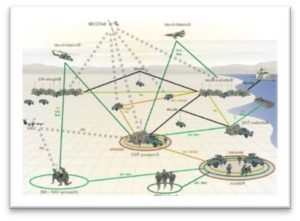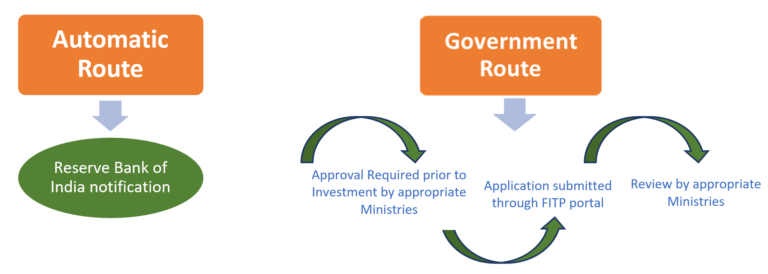Opportunities in the Indian-US Defense Sector
Arlington, Va. December 14, 2021 – Recent changes to India’s Foreign Direct Investment (FDI) regulations and the signing of mutual security agreements with the US have created enhanced opportunities for external investment into India’s aerospace and defense industries. FDI opportunities in India were previously capped at a 49% minority interest but have been recently raised to 74% in order to stimulate indigenous manufacturing capabilities. Potential investors in India’s aerospace and defense industries that wish to take advantage of the increased FDI opportunities will require astute, knowledgeable, and well networked counsel to navigate their course.
India and the US have been steadily increasing their strategic, defense, and trade initiatives, resulting in increased investment opportunities in India for foreign investment. India, the largest democracy in the world, has the 6th largest GDP worldwide[1] and the 5th largest defense budget, spending approximately US$73 billion in 2020.[2] Both countries have recently finalized several defense and trade initiatives resulting in over $21 billon of bilateral defense trade to date, while reducing restrictions on FDI regulations should lead to further investment flows. In contrast, outbound investments from India are active and growing with approximately $12.2 billion invested in the US from April to December 2020, followed by Singapore ($2.36 billion) and the Netherlands ($1.5 billion). There remain a number of issues for multinational corporations to work their way through – including tax policies, legal requirements and differing bureaucracies – but the stage is set. The opportunity for investors goes beyond India and includes such broader investments as developing joint manufacturing platforms for Indian production and exports throughout Southeast Asia.
After gaining independence in 1947, India relied upon the former Soviet Union for much of its military and organization. In the last five years, Russia had the largest share of India’s arms imports at 49%, followed by France at 18% and Israel at 13%,[3] despite the world’s five largest defense firms all being from the US. India and the US started increasing their defense cooperation in 2021 with the Defense Trade and Technology Initiative (DTTI), focusing on collaborative research and co-production, and since then several additional foundational pacts have been finalized. These DTTI initiatives included unmanned aerial vehicles (UAV’s), transport aircraft components, protective gear for contaminated battlefields, and launch systems technology for India’s aircraft carrier programs. The ten meetings to date set the stage for further agreements, opening the sector to Indian private businesses, creating Joint Working Groups (JWT’s) and defense agreements including LEMOA (2016), COMCASA (2018), STA-1 (2018) and BECA (2020).
[1] International Monetary Fund World Economic Outlook, April 2021
[2] Stockholm International Peace Research Institute, The Indian Express, October 17,2021
[3] India, Israel to work on 10-year roadmap for defense cooperation, Hindustan Times,

The Logistics Exchange Memorandum of Agreement (LEMOA) allows the US and Indian militaries to resupply from respective ports, land bases, and airfields, and has been very instrumental in increased naval communications.

The Communications Compatibility and Security Agreement (COMCASA) further increased the flow of communications gear between the two countries, including military-to-military encrypted communications systems between warships and aircraft. India was granted Strategic Trade Authority Tier 1 (STA-1) status in 2018, which allowed US companies to export dual-use equipment and technology under a streamlined process, permitting India to receive license-free access to military and dual-use technologies regulated by the Department of Commerce.

Most recently, the 2020 signing of the Basic Exchange and Cooperation Agreement (BECA) allows for the transfer of real-time geospatial intelligence such as maps, satellite imagery, geodetic, geophysical, topographical, and aeronautical data enabling advanced UAV and missile navigation and targeting. These programs increase the opportunity for both Foreign Military Sales (FMS) and Direct Commercial Sales (DCS), while also providing growth in local jobs, Make in India initiatives, and growing the industrial bases of both countries.
FMS programs to date include a multi-billion order for MH-60R Seahawk and Apache helicopters, and the Large Aircraft Infrared Countermeasures initiative. Even more recently, The Hindu reported that India is scheduled to finalize the purchase of 30 General Atomics Reaper and Predator UAV’s in December 2021.[4] Advocacy for aircraft platforms such as the Boeing F/A-18 Super Hornet and F-15EX Eagle continues, both for air superiority as well as equipping India’s emerging aircraft carrier fleet and capability. The Indian Navy currently operates the 45,000 tonne INS Vikramaditya, purchased from the former Soviet Union and is completing its second carrier, the locally manufactured 37,500 tonne INS Vikrant. Both are “ski-jump” carriers and operate MIG-29K aircraft and helicopters. A planned 65,000 tonne INS Vishal flat-top carrier may utilize US F-18E or French Rafaele aircraft. The Vishal would employ catapult assisted take-off capability and newer technologies, although these come with a significantly higher cost and under review by the government.
Since 2015 there has been over $3 billion in defense sales via the DCS process, including military electronics; fire control, laser, imaging, and guidance equipment; and aircraft related assets. Before 2001, domestic private industry wasn’t permitted to participate in this sector and foreign and domestic firms were subject to mandatory industrial licensing. Those policies are being reviewed and revised, including several new measures that have been introduced by the Ministry of Defense with the goal of simultaneously increasing participation by the private sector, raising the limit on FDI ownership levels from 49 to 74%, imposition of import embargos, and emphasizing Make in India programs. The Make in India programs are an attempt to achieve industrial self-reliance and reduce the large percentage of imported defense items.
[4] The Hindu, India set to seal $30 billion Predator Drone deal with US, November 17, 2021
There are two routes for approving FDI into India, illustrated as:

Under the Automatic Route, the non-resident or Indian company does not require any approval from the Government of India, instead notifying the Reserve Bank of India on the investment. Under the Government Route, approval from the Indian government is required prior to investment, and proposals for all FDI are considered by the respective Ministry or Department.[5] The Government Route process includes filing an Application Proposal with documentation on the Foreign Investment Facilitation Portal www.fifp.gov.in/. The Department for Promotion of Industry and Internal Trade (DPIIT), which resides under the Ministry of Commerce and Industry, is responsible for India’s policies relating to FDI. It provides updates and data to promote the overall amount of FDI into India and policies are updated annually at https://dpiit.gov.in/foreign-direct-investment/foreign-direct-investment-policy. The DPIIT routes the proposals to the appropriate Ministry where the formal review procedures begin.
There are approximately two dozen large private firms in the Indian defense sector, more than 100 medium sized-size companies, and approximately 6,000 small and medium sized businesses.[6] Previous efforts by the Indian government to open the sector to increased amounts of FDI have failed in generating significant investment by foreign firms. As a result of earlier failures, the Indian government has increased the FDI threshold from 49% to 74% interest through the Automatic Route. However, this level of investment may still require approval in accordance with Ministry of Defense guidelines and the timelines for receiving approvals are not always transparent.
India hopes this increase in FDI will benefit both foreign and local firms competing for defense contracts, although India has demonstrated a clear preference for Indian firms in awarding contracts to increase self-reliance and the indigenization of the Indian defense industry. These preferences are illustrated in the Defense Acquisition Procedure 2020 document that discusses higher levels of local manufacturing and India’s plans to spend approximately $150 billion on defense and achieve a 70% indigenization rate by 2027. While challenges remain to overcome legacy bureaucratic, local firm preference, and tax issues, there’s been promising progress in opening the sector to overall domestic and foreign FDI.
[5] Made In India, FDI Entry Routes, https://www.makeinindia.com/policy/foreign-direct-investment
[6] India’s push for self- reliance brings public private rift to a head, Vivek Raghuvanshi, www.defensenews.com
There are numerous government and private organizations involved in assisting Indian–US defense trade in both countries. US federal organizations assisting the defense trade include the US State Department, the Bureau of Political – Military Affairs, the Department of Commerce Office of South Asia, and various military attachés. The State Department recently published its 2021 Investment Climate Statements: India Report that discusses the inbound and outbound investment climate and issues with India.[7] Private organizations assisting the defense trade include the US-India Business Council (USIBC), the US-India Strategic Partnership Forum (USISPF), and the American Chamber of Commerce (AMCHAM). Indian organizations assisting the defense trade include the Confederation of Indian Industries (CII), the Federation of Indian Chambers of Commerce and Industry (FICCI), and the Society of Indian Defense Manufacturers (SIDM). These organizations are involved in Indian and US aerospace and defense conferences, airshows, trade-related missions, and assisting local government and private firm initiatives in this sector.
There are several upcoming airshows and conferences in the Indian defense sector, including the Aero India airshow (next held on April 3, 2023 https://aeroindia.gov.in/), India’s largest biennial military airshow. The last Aero India airshow, held in February 2021, attracted 78 foreign exhibitors from 14 countries and was held at the Yelahanka Air Force Station, Bengaluru. Another upcoming event in the Indian defense space is the DefExpo Conference (March 10-13, 2022 in Gandhihagar, Gujarat https://defexpo.gov.in/page/about-defexpo-2022), one of India’s main defense conferences. Indian Defense Minister Rajnath Singh specifically urged a group of defense attachés and industry representatives to attend the DefExpo Conference at an October 2021 round table. With 3,000 delegates from 70 countries, Singh mentioned an emphasis on space, cyberspace, and disruptive technologies such as artificial intelligence and virtual reality, saying: “It is because of the collaborative efforts of entities from all over the world that our defense exports have grown by 334 percent in the last five years and now India is exporting to more than 75 countries. Our export performance is a strong indicator of the quality and competitiveness of our defense products.”[8]
However, challenges for multinational firms still remain as illustrated by a recent decision in the procurement of anti-air gun systems for the Indian Navy. The Indian Navy reversed earlier plans to purchase BAE Systems Mk 45 systems and instead, offerings from a local Indian consortium were selected. While this highlights India’s commitment to its Make in India priority of self-reliance procurement over imports, it also provides a cautionary tale on the difficulties faced by foreign defense firms investing time and resources to procure business with the Indian military.
The US, India, Japan, and Australia formalized the QUAD military agreement in 2020. While not a formal alliance, its primary purpose is to increase the interoperability of QUAD members’ military technologies. Japan and Australia are both heavily invested in US military platforms and technology, so India’s history of purchasing Russian defense systems places it at a disadvantage in coordinating with other QUAD members. The recent announcement of AUKUS, the Australian-UK-US security partnership, and Australia’s purchase of US nuclear submarines (at the expense of French-designed conventional submarines) will also have a bearing on future Indian-US defense contracts. The French may try to sweeten new French-Indian defense opportunities to make up for the loss of the Australian submarine contract, which should benefit India, as will the increased US and UK involvement in the region. Ultimately, the overall increase in foreign defense involvement by all the countries trying to do business with India’s defense sector should lead to increased FDI opportunities.
The US and India are making steady progress in increasing overall levels of FDI into India; and while challenges remain, the US and Indian governments and businesses have re-started discussions. Recent DTTI Interagency Task Force meetings and calls included 200 public and private firms from both countries and, promisingly, included an increasing number of small to medium-sized enterprises (SMEs). Many of these newer SME’s have UAV, artificial intelligence, and cybersecurity products that they are eager to showcase and the next round of discussions planned for March 2022 should continue this trend. These meetings, trade shows, and discussions should result in increasing opportunities for foreign direct investment into the Indian defense sector.
[7] https://www.state.gov/reports/2021-investment-climate-statements/india
[8] Run-up to DEfExpo-22: Rajnath Sigh reaches out to global defense industry, October26, 2021
About FON
FON is a financial advisory firm dedicated to investment banking, valuation advisory, management consulting, and principal investing across the aerospace, defense, and government services industries. The FON Global Alliance supports domestic and cross-border transactions through its network of 25 affiliated companies, including located throughout the Americas, Europe, the Middle East and Africa, and Asia/Pacific. Member firms seamlessly deliver independent advisory services from valuations for financial and tax reporting/compliance matters to investment banking services (mergers & acquisitions, divestitures, restructuring, capital markets) to real estate insights & advisory to market, economic, and competitive intelligence.
Get in Touch
Have questions or want to learn more about how FON can help your business? Contact our team:
 Raymond Moran, ASA, MRICS Managing Director  rmoran@fonadvisors.com | rmoran@fonadvisors.com |   +1.571.842.1799 +1.571.842.1799 |  Jouky Chang Managing Director and Practice Leader  jchang@fonadvisors.com | jchang@fonadvisors.com |   +1.571.842.1800 +1.571.842.1800 |
